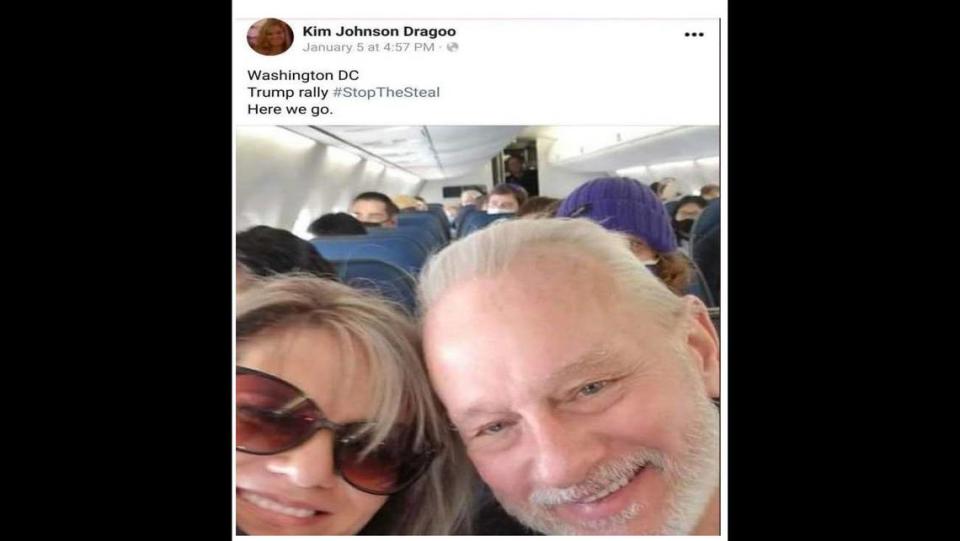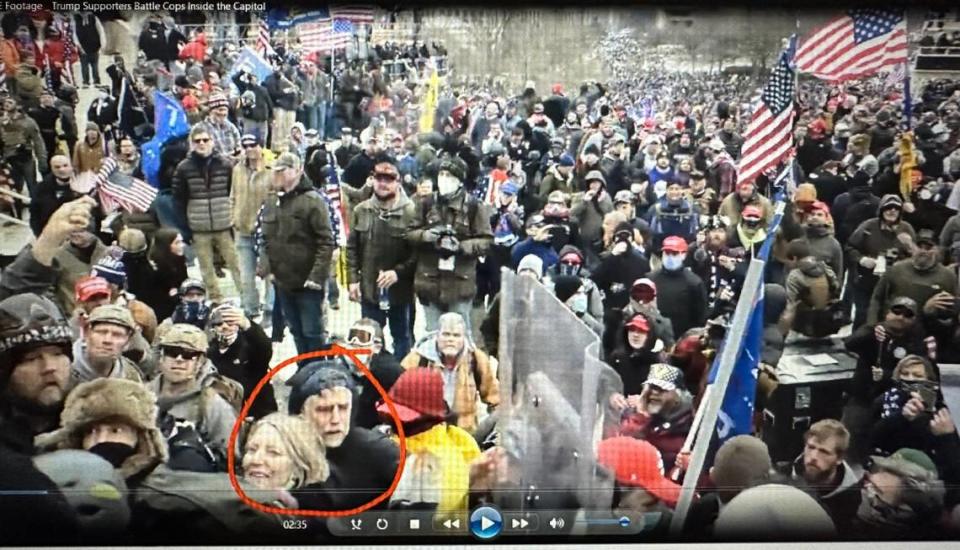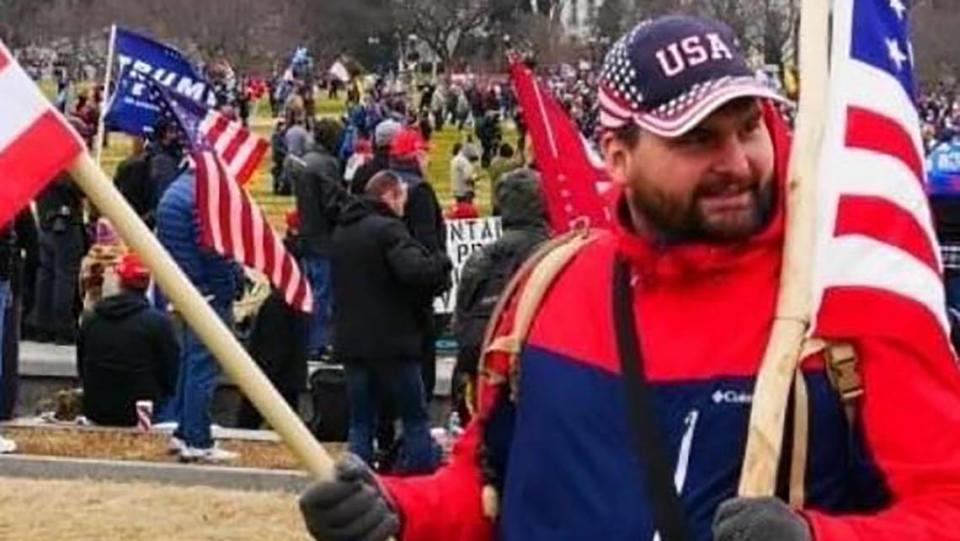Pace of Jan. 6 arrests picks up with help of citizen tips — 2½ years after Capitol riot
Two-and-a-half years after rioters stormed the nation’s Capitol, the massive investigation has picked up the pace, with authorities rounding up suspects from California to New York, often aided by online sleuths who help identify them.
A Maryland man charged with assaulting officers while wielding a flagpole. A Long Island man accused of spraying police with insecticide. A Los Angeles resident arrested for fighting police in a tunnel leading into the U.S. Capitol and carrying a stolen police riot shield.
The recent arrests include a man taken into custody near former President Barack Obama’s home on June 29 with guns and hundreds of rounds of ammunition in his nearby van. Three Missouri residents were caught in the latest wave as well.
Steven and Kimberly Dragoo, of St. Joseph, were charged with four misdemeanors after they documented their breach of the Capitol — including a photo of Kimberly Dragoo entering through a broken window. And Kansas City church staffer Kyle Kumer — who authorities said took his mom to the Capitol and participated in a concerted “heave-ho” movement against a line of officers protecting an entrance — was charged with a felony and three misdemeanors.
Arrests continue to mount in the probe described by Attorney General Merrick Garland as “one of the largest, most complex, and most resource-intensive investigations in our history.”
The arrest tally stands at more than 1,000, on charges ranging from demonstrating in a Capitol building to seditious conspiracy. And prosecutors vow to continue tracking down the remainder of the estimated 2,000 to 3,000 protesters who breached the Capitol, causing nearly $2.9 million in damages.
Some of the recent arrests are for minor offenses — the Dragoos were in the Capitol less than two minutes. Others, such as those involving assaults on officers, are much more serious. And the continued push to file charges appears to indicate that the investigation isn’t close to wrapping up.
“The U.S. government, the FBI, the Justice Department, are persevering, and they’re following through with prosecuting these people who invaded our Capitol and caused all this damage and tried to disrupt our democracy,” said Daryl Johnson, a former senior domestic terrorism analyst for the Department of Homeland Security.
When asked how long the investigation is expected to go on and whether it has the financial resources and staff to continue tracking down and prosecuting more suspects, the Justice Department declined to discuss the issue.
“We cannot make any comments about this ongoing matter,” said Patricia Hartman, a spokeswoman for the U.S. Attorney’s Office in Washington, D.C., in an email to The Star.
But a letter last fall to the D.C. federal court from Matthew Graves, U.S. attorney for the District of Columbia, said that more than 1,000 additional suspects could still face charges in connection with the Capitol attack, according to Bloomberg News, which reviewed the document.
The letter, dated Oct. 28, was written at the time the number of arrests neared 900, Bloomberg reported in a story published in March. The government estimated there could be 700 to 1,200 more defendants.
Graves told then-Chief Judge Beryl Howell in the letter that it was difficult to predict future cases because of the “nature and the complexity of the investigation,” Bloomberg reported. Graves said he expected a higher percentage of felony charges than misdemeanors.
“We expect the pace of bringing new cases will increase, in an orderly fashion, over the course of the next few months,” Graves wrote, according to Bloomberg. He concluded by saying the arrest predictions could change as the office continued to “evaluate changing resources and circumstances.”

In monthly updates on the status of the investigation, the Justice Department has repeatedly said that “the Department of Justice’s resolve to hold accountable those who committed crimes on January 6, 2021, has not, and will not, wane.”
And on May 4, in lauding the conviction of four Proud Boys leaders who were found guilty of seditious conspiracy, Garland said the verdict “makes clear that the Justice Department will do everything in its power to defend the American people and American democracy.”
“Our work will continue,” Garland said. “Today’s verdict is another example of our steadfast commitment to keeping those promises. The Justice Department will never stop working to defend the democracy to which all Americans are entitled.”
Help from the public
The government acknowledges that the public has played a crucial role in the mammoth investigation. More than 1,069 people in nearly all 50 states and the District of Columbia have been charged so far, according to the latest Justice Department figures, dated July 6.
Hundreds of thousands of people have called the FBI’s tip line to report friends, neighbors, colleagues — even relatives — who stormed the Capitol.
“Citizens from around the country have provided invaluable assistance in identifying individuals in connection with the Jan. 6 attack,” the Justice Department said in its July update. “The FBI continues to seek the public’s help in identifying approximately 323 individuals believed to have committed violent acts on Capitol grounds.”
The FBI’s “Capitol Violence” website contains 14 videos of rioters wanted for violent assaults on federal officers. One of those suspects can be seen in a video striking multiple officers with what looks like a stick, the FBI says, and three others are shown charging at and assaulting officers.
The website also displays more than 1,400 photos of suspects the FBI is asking for help to identify.
Among the most productive in identifying and tracking down suspects are the “sedition hunters,” a loose network of online investigators who spend countless hours scouring the web, social media sites and often-overlooked places searching for even the smallest details that could help determine a suspect’s identity.
These sleuths — some anonymous amateurs, some professional researchers and some who are part of organizations including Deep State Dogs, Capitol Terrorists Exposers and Capitol Hunters — have gathered evidence that has helped identify hundreds of rioters.
One group, the Sedition Hunters, describes itself as “a global community of open-source intelligence investigators (OSINT) working together to assist the U.S. FBI and Washington D.C. Capitol Police to find those who committed crimes on January 6 at the Capitol.”
The group, whose Twitter profile name is “TheRealJ6,” says it has examined thousands of hours of videos and hundreds of images. It also creates “Do You Know” posters and composites, asking the public to share them on social media platforms such as Facebook, Twitter, Instagram and YouTube.
The Sedition Hunters website has a section called #SeditionInsiders that currently displays 3,200 photos of people it says were observed inside the Capitol during the riot.

On June 7, the FBI arrested Long Island funeral home director Peter Moloney two weeks after the group called out authorities on Twitter for failing to file charges nearly 700 days after online investigators had identified him.
“It’s been 694 days since 199-AOM #BlackBonoHelmet was identified and reported by online researchers,” the May 24 tweet said. “The Long Island business owner used a can of Wasp killer to assault officers, yet to date has not been arrested. Why hasn’t the #DOJ brought charges?”
Moloney now faces eight charges, including assaulting, resisting or impeding officers, civil disorder and assault by striking.
Prosecutors say that during the initial breach of the Capitol grounds, Moloney removed a can of wasp, hornet and yellow jacket spray from his backpack and used it on police officers at least twice. Two other times, Moloney joined rioters in surrounding and striking people they thought were members of the media, according to a charging document.
The document cites an image from a video tweeted by the Sedition Hunters that the government used as evidence to identify Moloney as a participant in the riot.
Threats to McCarthy, Obama
In August 2021, the Deep State Dogs identified D.C. chiropractor David Walls-Kaufman as one of the rioters seen brawling with police inside the Capitol — including a confrontation with Metropolitan Police Officer Jeffrey Smith, who can be seen on video collapsing in the middle of the mob.
Soon after identifying Walls-Kaufman, the Deep State Dogs and others in the network identified Taylor Taranto of Washington state as the other person allegedly involved in the skirmish with Smith. The officer died by suicide nine days after the riot.
Walls-Kaufman was charged in 2022 with four misdemeanors, pleaded guilty to one count — parading, demonstrating or picketing in a Capitol building — and was sentenced June 13 to two months in jail. Taranto wasn’t arrested until late last month, when he was picked up near Obama’s home June 29 on a warrant for charges related to the insurrection.
In a document filed in federal court Wednesday, the government said the FBI had been monitoring Taranto’s online activities since he’d been identified as a participant in the Capitol riot. Authorities were having trouble finding him, it said, because he’d recently moved to the D.C. area from Washington state and had been living in his van.
But on June 28, the document said, Taranto started live streaming on a public YouTube channel. He said he was in Maryland and headed to the National Institute of Standards and Technology, which has a nuclear reactor on its property. He said he was “just going one way for this mission, to hell,” that his vehicle was “self-driving” and that he had a detonator and planned to blow up his van there.
During the live stream, the court filing said, Taranto also made ominous comments referencing Maryland Democratic Rep. Jamie Raskin and Republican House Speaker Kevin McCarthy, saying, “Coming at you McCarthy. Can’t stop what’s coming. Nothing can stop what’s coming.” After seeing the live stream, the FBI alerted other law enforcement, and the federal court issued an arrest warrant based on Taranto’s alleged Jan. 6 crimes.
The next day, former President Donald Trump posted what he claimed was Obama’s address on the social media platform Truth Social, according to the document. Taranto then re-posted it on his own Truth Social account. Then, Taranto wrote on Telegram, “We got these losers surrounded! See you in hell, Podesta’s and Obama’s.”
Soon after that, the court document said, Taranto began live streaming from his van while driving in a residential area of D.C. He exited the van and started walking through the neighborhood, continuing to stream. He made several concerning comments about the residences in the area, the filing said, saying he was searching for “entrance points” and that he “had them surrounded” and was going to find a way to the “tunnels underneath their houses.”
“He also repeatedly stated that he was trying to get a ‘shot’ and that he wanted to get a ‘good angle on a shot,’” the government said in its filing.
When Taranto saw uniformed Secret Service officers approaching, he headed into a wooded area and tried to flee but was arrested, the document said. A search of his nearby van found hundreds of rounds of 9mm ammunition, two firearms, a machete and a mattress inside.
So far, Taranto is charged only with four misdemeanors related to the Capitol riot, but prosecutors say they intend to file felony charges. The charging documents involving Jan. 6 say Taranto and Walls-Kaufman scuffled with police inside the Capitol and that Taranto fought with other rioters outside, using a cane to fend them off.
Taranto and Walls-Kaufman also are co-defendants in a civil lawsuit filed in August 2021 by Officer Smith’s wife. The lawsuit alleges that the men contributed to Smith’s death. The suit says Taranto assisted Kaufman during an altercation with officers and that Kaufman grabbed Smith’s baton and violently swung it, striking Smith in the head and causing a concussion. Both Taranto and Kaufman have denied the allegation.
Johnson said the work of the online detective community has been invaluable to the federal investigation — and has helped keep it going.
“They’re holding the Justice Department’s feet to the fire, holding them accountable, to make sure that they follow through with these arrests,” he said. “I think without those people’s help, we may have reached the end of this investigation.
“We’re two-plus years removed from the riot, and the news cycle has moved on to other things. The Justice Department has rounded up over 1,000. Once they hit that threshold, I think they could say, ‘Hey, we did our job, blah, blah, blah.’ But these private groups are doing a great job because they’re doing a lot of legwork and sending them these referrals. And once the FBI and DOJ get the referral, they’ve got to follow up on it.”
Videos, transparency at issue
As the Jan. 6 investigation persists, so does a battle over access to Capitol Police security video from that day.
The issue flared up in February when McCarthy granted then-Fox News host Tucker Carlson exclusive access to view more than 40,000 hours of footage. Carlson then aired dozens of clips on his shows, downplaying the violence and portraying protesters as mostly peaceful.
The Justice Department, however, says about 140 police officers were assaulted at the Capitol on Jan. 6. Eighty were from the U.S. Capitol Police and 60 were from the Metropolitan Police Department.
About 350 defendants face charges of assaulting, resisting or impeding officers or employees. That includes 110 people charged with using a deadly or dangerous weapon or causing serious bodily injury to an officer.
After facing intense criticism for his decision, McCarthy said he planned to make the footage available to the broader public and to lawyers of defendants charged in the insurrection.
A Jan. 6 defendant from Kansas charged with multiple felonies has been at the forefront of the push to make those videos public. William Pope, of Topeka — who is representing himself in his case — wants U.S. District Judge Rudolph Contreras to release videos that he says include footage of undercover Metropolitan Police officers inciting protesters to breach the Capitol.
The government has argued that the videos have been designated “sensitive” and “highly sensitive” and that it would be a matter of “grave national security” to make them public.

In March, a coalition of more than a dozen media companies filed a motion to intervene in Pope’s case. They asked that the court permit Pope to release the videos to the press and public. The coalition argued that many of the video clips had already been made public, including some aired on Carlson’s shows. The judge has not yet ruled on the issue.
Pope has called the videos “clear evidence of undercover provocateurs” and has filed a series of motions saying he has a right to see them. He has appealed to the U.S. Court of Appeals and is awaiting a response.
Meanwhile, following the Jan. 6 cases through the courts has gotten more difficult.
In 2020, in response to the pandemic, Congress granted special authority for federal courts to hold hearings in criminal cases by video conference or teleconference. That included an access line that allowed the public and the press to listen to those hearings by phone or through the internet.
But on April 9, the national emergency declared with respect to the pandemic was terminated, and on May 9, Chief Judge James Boasberg issued an order for the D.C. federal courts to stop providing public audio feeds to criminal proceedings.
So even though some hearings are still taking place via Zoom, judges have stopped allowing the public to listen in on the audio feeds. Now, public access to criminal hearings conducted by video or teleconferencing is only available in the courtroom of the presiding judge.
Critics of the ruling, including some defendants, say it results in less transparency.
“My opinion is that the court should allow more public access, not less, especially when the January 6 cases come from all over the country,” Pope said. “This is another aspect of future arrests that isn’t being talked about much — these new cases will likely not receive as much local coverage because it’s more difficult for journalists to follow.”
Jan. 6: A campaign issue in 2024
Amid all the clashes over issues related to the Capitol riot, there’s one thing everyone seems to agree on.
The Jan. 6 investigation is certain to be an issue in the 2024 election.
When Biden announced in April he was running for re-election, the first scenes in his launch video were of the Capitol riot. Trump, who is under investigation into whether he and his allies tried to overturn the 2020 election results, has vowed to pardon “a large portion” of the Jan. 6 defendants, who call themselves political prisoners and say they are being persecuted for their beliefs. And a House subcommittee continues to hold hearings on the so-called “weaponization” of the federal government against conservatives, including its handling of Capitol riot cases.
“I think for a segment of voters, it will be a big issue,” said Don Haider-Markel, a political science professor at the University of Kansas. “You can’t deny that Biden at least in part is basing the foundation for running for re-election on January 6, but linking that to Charlottesville as well, which was the impetus for his 2020 campaign.”
Trump is using January 6 in a similar way, Haider-Markel said, trying to mobilize voters by calling investigations of him “witch hunts” instigated by his political enemies to delegitimize his 2016 election.
“And then there are people on either side that actually are really concerned about January 6, and then those who think it was a sort of setup or something,” he said. “So I think in the 2024 election, January 6 definitely matters.”

